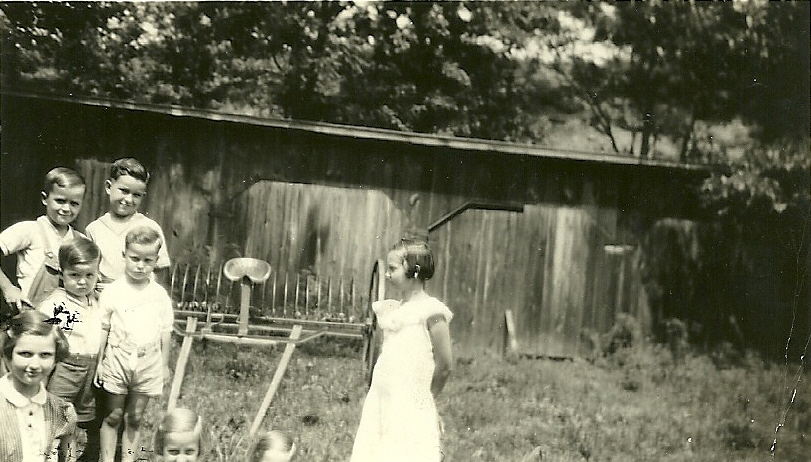
History of Mineral Wells, WV.
Community Settings
The Mineral Wells Community embraces an area formed from a part of Tygart and Slate Districts north and south on the Elizabeth Pike, Rt. 14, from Pettyville to the top of Butcher Hill, a distance of approximately five miles. It embraces all the section from the Pike to the Little Kanawha River on the north from a point across from Nicollette to and including the A. D. Hopkin's Experiment Farm. (For more history on Andrew Delmar Hopkins check him out on Wikipedia) On the south side of the Pike it includes an area encircled by the Pettyville Road past the Pete Deem's farm to the point where it joins the Tygart Road and extends south on that road to and including the J. D. Leach place; thence straight east across Route 21 to and including Chesterville and north again to the Elizabeth Pike.
Included in this area are the settlements of Mineral Wells proper, Chesterville, and The Butcher Hill Hunt Club, and the former settlements: Scarecefat, Leafy Glenn, Mt. Zion; the estates of many residents of long standing including those of Robert Page, Billy Deem, John Barnett, E. S. Butcher; and the following institutions and landmarks: A. D. Hopkin's farm; Fairview, Tygart, and Chesterville Schools; Butcher Hill Hunt Club; Mt. Zion, Chesterville, and Mt. Pleasant Churches.
This territory was once a part of a 28,000-acre survey that George Washington expected to buy. His survey was to have extended from the mouth of the Little Kanawha River, up the bed of the river fourteen miles or beyond Butcher Hill. Mr. C. R. Rector has in his possession a copy of the large survey. However, for some unknown reason George Washington never bought it.John Cooper owned the land now known as Mineral Wells. Red Selectman bought this farm around 1850 and dug a well, the water of which seemed to have a curable effect for dropsy and other troubles. One man who had not seen his feet for twelve or fifteen years, after drinking this water a few weeks, lost thirteen inches in waist measurement, and continued drinking the water until he became normal size.
The news of this cure spread until Mineral Wells became a great summer resort by the early 1860's. Many people came from Parkersburg and other places to stay all summer or just a day. Sweet corn was consumed at the rate of one ox wagonload a day. When the mineral water was low the proprietor, a shrewd businessman, hired water hauled from the creek and wells of the neighborhood and poured into his wells at night in order to keep up the supply. Old irons and salt were put in for the mineral effects. The business flourished for many years. A large hotel was built to accommodate the visitors. It had a large dining room containing ten twelve-foot tables that ran the length of the front of the building. A smaller dining room had four tables in it. An outside stairs led to the upstairs porch that extended the full length of the hotel. The guest rooms opened onto the porch. Dancing and bowling were main diversions and there were many grapevine swings in the grove to offer amusement. The building burned in 1900. The ruins of the foundation and the two wells are still to be located.
Corn and wheat were ground by a water mill at Chesterville as early as 1820 by a family of Jake Deems. This mill was later operated by Henry Page. In the 1870's a steam mill was built a little farther down the creek. It was owned by John Badger and later by a family of Lesters, and then by George Rector. Mr. Rector put rolls in the mill and did extensive business for several years. Chesterville was quite a village about the year 1890. It had this flourishing mill, three stores, (one a company store) and the others owned by Mr. H. S. Dye and Joe Heatherly, and a blacksmith shop owned by John Smith, and Dr. A. K. Rose practiced here. The flood of 1889 destroyed some of the property and the business life of the community gradually declined.
The pioneer settlers were of necessity very industrious. They raised their own food and made their own clothing. The food was cooked in iron ovens among the coals of the big fireplaces that usually occupied one end of each cabin. The kettles and pots were hung from cranes over the fire. Some of the bread was baked on boards slanted before the fire. The fiber for clothing was raised and later manufactured at home. Many happy hours were spent in the picking, combing, and carding of wool and flax later used in weaving into material for all of the garments the family needed. Some of the women were excellent weavers and set a good example for the younger women. The hose for the entire family were knit from the wool that was raised, sheared, and carded at home. Often the socks men wore were in natural color of wool.
The shoemaker made his rounds, staying in each home until the supply of boots and shoes was made for each member of the family. This often required quite a length of time. The boots and shoes were always made from home tanned leather. Two of the early shoemakers were Henry Bailey and Pete McCardle. They were good cobblers and always busy. The corn and wheat were ground on water mills; one at Chesterville, one at Davisville, and one on Big Tygart that was destroyed by the flood of 1884.
After the crops were gathered, many of the farmers would gather what grain they could spare along with the staves which they had cut, and bark that they had gathered the previous season, and would haul them to the Little Kanawha River near the Creel Farm. There they would load the products into barges and float down the Kanawha River to the Ohio River and on to some trading center. Several trips were made in this way to New Orleans. Enoch Rector, John Page, Tom Stephens, and John Barnett were among some of the first to make this trip. In exchange for their produce the farmers would bring back sugar and molasses, and sometimes other dainties for their families.
The first transportation of goods was carried on by ox-carts. Horses and wagons came later, and for those who could afford it, buggies became the general means of travel. In the early part of the 1900's came the marvelous Model 'T' Ford.
The desires of these early people for social life was much the same as that of ours today; but instead of leaving their homes and journeying for many miles to find enjoyment, they visited with their neighbors and helped with the raising of a new house or new barn, husking corn, quilting, peeling apples, always spending the day at something useful. These people worked and played together and their amusement was clean and satisfying. At corn husking, the finder of the red ear always felt it his privilege to kiss the fairest girl. They danced to violins at apple peelings and quiltings. At log rollings, five and six acres were rolled in a day.
Stories of Pioneer Life
On the A. D. Hopkins farm is a grave that is about one hundred eighteen years old. When Mr. Hopkins came into possession of the farm, he found a rose bush growing on a grave, and the bush has never failed to bloom each year. There is also on the farm two very old log cabins; one where Blennerhassett and his wife were entertained on their way from Virginia to his home on the Island; another in which can be seen the port holes that were used to shoot through by the settlers to defend themselves from the Indians.
James Cooper saw a bear shot out of a tree where Oscar Barnet's house now stands. A darkie feeding the pigs saw the bear in the tree, returned to the house and reported his findings. Billy Poole went out and shot the bear.
In 1798 the stock was penned at night to protect it from wolves, according to a record found by Mr. Charles Rector. Deer were also quite numerous in this locality.
The Histroy of Butcher Hill
Edwin Butcher, a grandson of Samuel Butcher, around 1860, built a store and hotel at the foot of what is known as Butcher Hill. This was an enormous hotel that came to be known as the Half Way House because it is half way between Parkersburg and Elizabeth on Rt. 14 or Elisabeth Pike.
This was during the oil boom at Burning Springs in Wirt County and the traffic on Elizabeth Pike was heavy with the hauling of supplies to and from the fields. This became a natural stopping place for rest and meals for the men. The cattle dealers from Wirt, Calhoun, Roan and Gilmer Counties would drive their cattle and sheep on foot down Elizabeth Pike to the markets and also made this a stopping place. Mr. Butcher would buy and sell from them anything from ginseng roots to a farm.
In the picture above you can see Rt. 14, Elizabeth Pike Road, on the left that runs in front of the hotel and notice the wagon tracks. My parents told me that George Washington camped here when he was in the Valley surveying in 1770. Dad, mom and grandmother Butcher once lived here in this house. They had many stories to tell about that place. One night my mom woke dad up and told him that she heard someone in the house. Dad got up and got his 38 pistol and a lantern and went looking for the intruder. Come to find out it was just a rat.
Sometime around 1945 or 1946, Harvey Marsh bought this property and tore the large section on the left, which was the store, down and then separated the other two and moved the one on the right about 60 yards toward Butcher Hill. He then remodeled them both. My father, Kelsie Johnson, moved us into the one closest to Butcher Hill in 1947 and my uncle, Rome Butcher, bought the other house. Both houses are still standing. As far as I know, my grandfather Winfred Edwin Butcher Sr. was related to E. S. Butcher. Grandfather is buried along with my grandmother Mary Butcher and my uncle, Rome Butcher along with his wife Bess, behind the Mount Zion Baptist Church at Bonnieville.
This was the origional building and the store was once to it's left. This is the house my Uncle Rome Butcher bought.
This is the part of the origional building that was moved and we moved into it in 1947 when it was remodled. It looks quite different now. Then it had red buffed shingles on the sides and the porch and block addition was not there.

This is a picture of the old garage that was between the two houses. That's my brother Kelsie, my cousin Jr. Burkhammer, my brother Don, my cousin Frank Hathaway, my cousin Roseanna Hathaway, my cousin Martha Hathaway, and my sister Marjorie.
The first election for Mineral Wells Community was held at the Edwin Butcher place at the foot of Butcher Hill on May 3, 1863.
Butcher Hill Hunt Club
The Butcher Hill Hunt Club was located on the Butcher Bend Road about a mile from Elizabeth Pike Road at Butcher Hill. Butcher Hill Hunt Club, Inc. is a West Virginia Domestic C Corporation filed on December 8, 1934. The Company has 3 principals on record. Two of them are Burton Thorne and R. E. Hays.
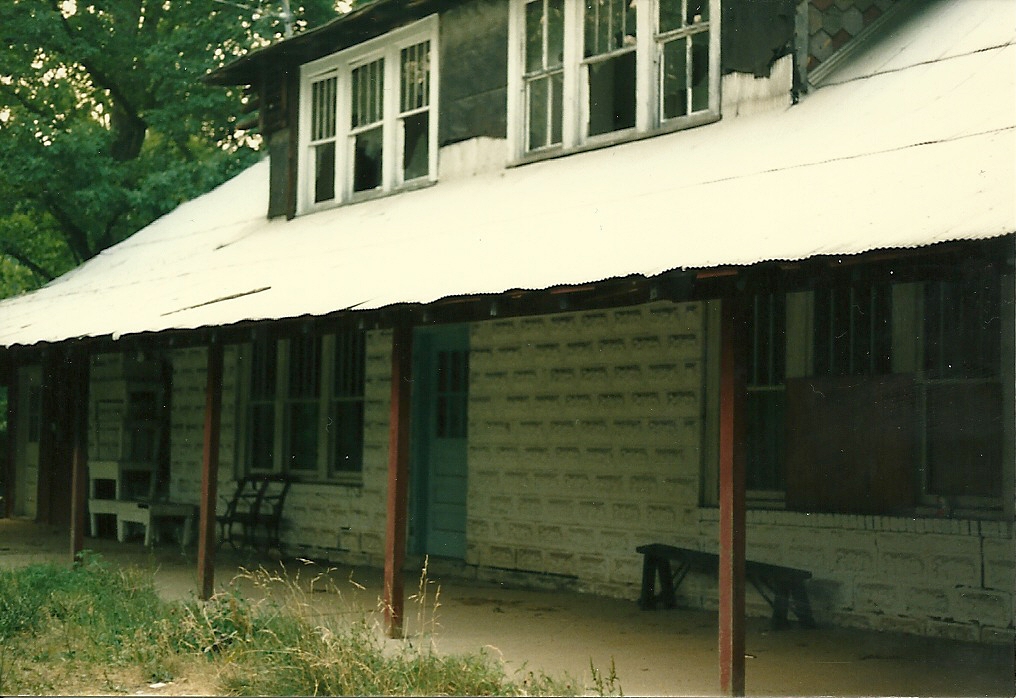
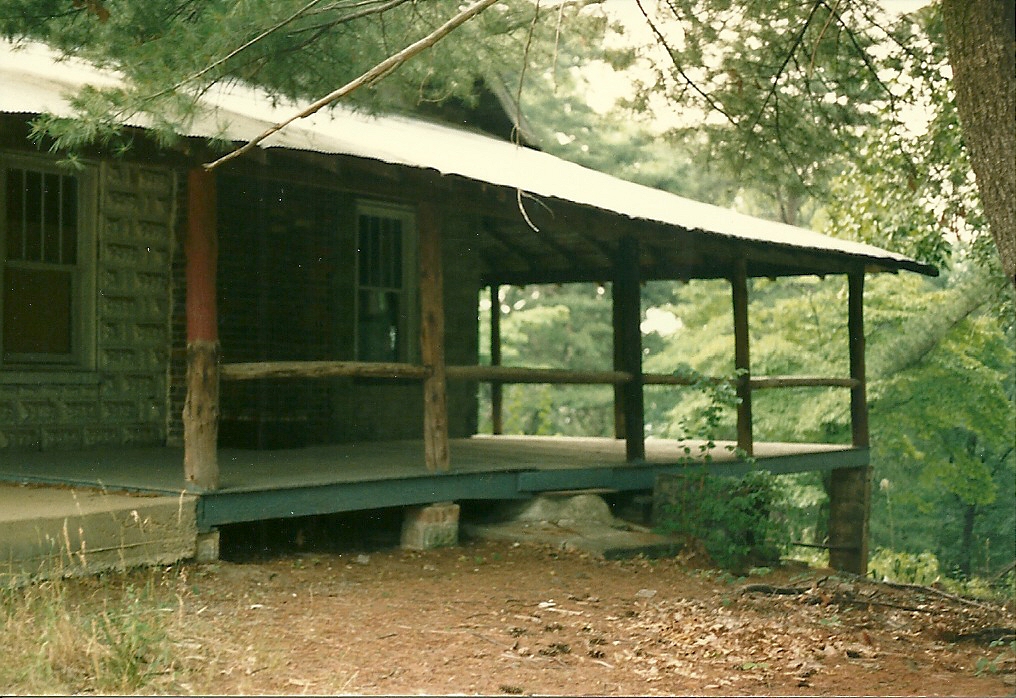
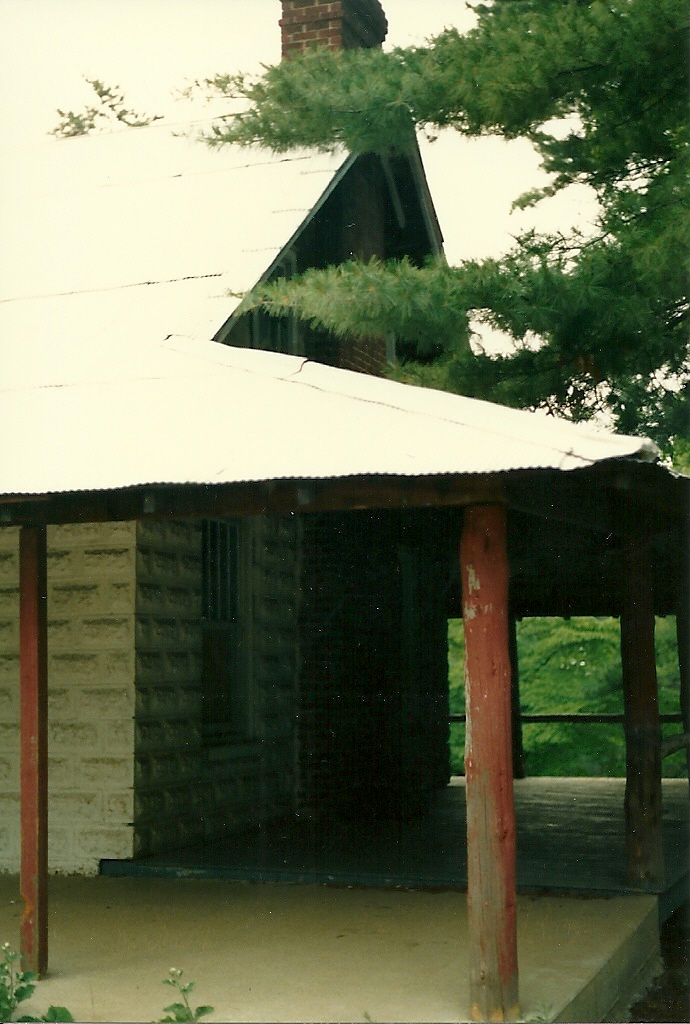
The Hunt Club was the center of social activities during the 30's through the early 50's. The Club would hold dances and many fox hunting events. My grandmother, Mary L. Butcher, was the custodian for the Hunt Club during the 40's and early 50's. My dad was an avid fox hunter and we kept fox hounds for Lawrence Cooper and Tom Graham. At one time we were keeping 30 fox hounds who ate 100 pounds of dog food every day. These fox hunters could tell you whose dogs were chasing the fox by listening to their bark.
The Hunt Club is owned now by Rick Golf, who is the electrical inspecter for the city of Parkersburg, and he has converted it into a house.
Schools
The first school that we have any record of was a select school taught by David Harris in 1815 and located in the bend of the Little Kanawha River. The building was a log cabin built in 1805. The desks were made by driving pegs in the wall and placing boards across them. The seats were split logs with pegs for legs. When pupils were writing, they were obliged to stand in order to reach their crude desks. Their pens were made of quills. The building had no floor, save the earth and was heated by a huge open fireplace. Mr. Wolf taught writing and arithmetic by making letters and numbers on a wooden paddle with charcoal. He named the bend of the River "Hell's Bend" because the older boys teased and tormented him so much.
Other early teachers during the 1850's and later were: Mary Leary Sebastian Chevoront, Miss Wilcox, Mr. Starcher, Maria Hitchcock, Mr. McGee, Miss Lacy, Joe Buckner, Amanda and Andrew Price, and Texanna McKusick. These early teachers boarded from home to home.
A school was later formed at Clay Lick. This building was only a log cabin , but was later moved into a frame building located on the Pike and called Cooper's School, later Society Hill. The free school system was started about 1860. Since then the school systems have grown gradually. As the community developed the need arose for more school buildings. They were placed at Chesterville, Fairview, Leafy Glen, and Shady Hill. With the adoption of the County Unit System in 1933, Leafy Glen and Society Hill students, because their enrollments were so small, were transferred by bus to Shady Hill where a modern two-room structure had been built. Additional rooms were later supplied by portable buildings beside and behind the regular main one. Many community activities were held in the combined basement and auditorium of the Shady Hill building.
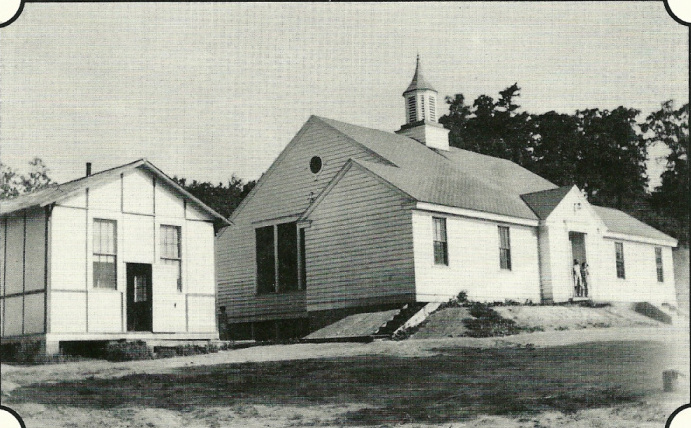
My father told me that there was a one room school just down from the Butcher Hill Hunt Club toward the river and that it had been taught by Carl Miller before he came to Shady Hill School. As a young boy, I saw the building still standing and it was pretty run down and all grown up and I didn't pay much attention to it.
The pupils of the community were, if they didn't attend Fairview or Chesterville Schools, transported by bus to Shady Hill for elementary work and then to Washington Junior High, or to Central High School. The rural children were given practically the same opportunities as the city children. Books were furnished the schools by the Wood County Carnegie Library. Music, Art, Penmanship, and Physical Educational supervisors visited the schools regularly.
Post Office
To provide connection with the outside world an early post-office was located at Fountain Springs in The Tygart District. This office was later moved to Leach's home. In 1860 Bill Fetzer, an old bachelor, was hired to tend the mail. He was followed first by William Taylor and later by John Leach.
The first post office in Slate District was at Lockhart's Run and had as its postmaster Mr. E. S. Butcher. Mr. Henry Dye was afterwards postmaster at this place for almost forty years. Later the name Roosevelt was adopted for this post office. The post office was finally transferred to Mineral Wells and located on Mineral Wells hill just above Sams Creek. Some of the early postmasters of Mineral Wells were: William Taylor, John Leach, and Mr. Prickett.
When the office was first established, mail was delivered to the office once a week from the Parkersburg Office. Later a twice-a-week delivery was established and finally every day service was granted. Mr. Sutton and Mr. Nicely were two of the early carriers from Parkersburg to Elizabeth. Three routes run out from the Mineral Wells office. Mr. W. L. Deem has served the greater part of the Community every since rural free delivery was established.
Three rural routes emanated from the Mineral Wells post office. Route 1 extends to Pettyville, bears left and comes back into Big Tygart Road to Sams Creek and part of Pleasant Hill Ridge, bears left to Sycamore, comes to McDonald Ridge, and retraces to the post office. Route 2 goes up Big tygart, Buck Run, and part of Lee Creek, Stephens Fork, and retraces. Route 3 includes the Elizabeth Pike to Butcher Hill, then on Grassy Run Road to Chesterville, Sunnyside, and back to the Pike by Chesterville Road; then down the pike to Society Hill Road past E. F. Schneider's and down Scarce of Fat Road to the bend of the River and back Turkey Foot Road past Mt. Pleasant Church to Pike and then to the post office.
Mr. W. L. Deem had the honor of being the oldest carrier in service in Wood County in 1936. On November 1, of that year, he completed thirty-one years of service and then retired from active service.Mills
There were three water mills in early days, one at Chesterville, one at Davisville, and one on Big Tygart. The mill at Chesterville was begun about 1820 and kept in operation until 1924.
Lumbering
About 1850 people began the building of frame houses. Prior to this time homes were chiefly built from logs. Some of the early carpenters were William Fought, Henderson Demm, Joshua Butcher, and Charles and Perry Page. As early as 1844 one man, John Barnett, made bricks on his own farm and built a large brick residence. This was the only brick house in the community for a number of years. A cyclone passed through part of the community in 1912 and blew the top from this house, but the building was repaired and is still standing and in good condition.
One of the early money-making industries was that of marketing railroad ties. They were hauled mostly to the mouth of the Big Tygart Creek and sold there . They were also shoved into the water, bound together by chains, and floated down the river to markets. Levi Stephens was a prominent trader in these ties. Many of the ties for the Little Kanawha Railroad were supplied from this locality. The cutting and selling "pit" posts or mine props followed in turn. Much of the timber has been sold out of the community in this manner.
Railroad
An outlet to market was added in the early part of this century for the farmers of the community. About the year 1898 the Little Kanawha Railroad was built from Parkersburg to Palestine. It passed along the Little Kanawha River and through the entire Mineral Wells Community. The railroad was very prosperous for about twenty years, but with the coming of improved roads and the more convenient transportation by truck, its business began to dwindle. It ceased operation sometime during 1935. Afterwards the tracks were removed.
In 1950, my father bought the 100 acre, old Grant farm which ran from Rt. 14 along the Butcher Bend Road at Butcher Hill to the Little Kanawah River. The railroad tracks ran right through our farm next to the river but by this time, the railroad tracks had been taken up . We used to play along these abanded track beds and wondered why the tracks were taken up.
During the early days of this railroad they had three engines: two for heavy freight, and one for passenger service. The passenger engine carried two coaches until the Grayhound Bus Line established a daily run between Parkersburg and Elizabeth and relieved it of its passenger business. I can remember riding that bus many times and we called the driver Whitey. He was a very nice man and was good to all the passengers. In early days the passenger train made two trips a day; one in the morning, and one in the late afternoon. In later years the number of trips were gradually cut down until finally it was making only one trip each week. It operated for a period of about thirty-five years.
"Scarecefat" or Creel Station was a flourishing little settlement during the latter 1890's. There were a few homes and a store located there. An interesting story connected with the place is it's getting the name of "Scarecefat." One story is told that a night prowler stole all the hogs from the residents. Someone later put a notice on one of the empty pigpens "Scarce of fat." It has been called that since then.
During the period from 1900 to 1920 farmers took their produce to Creel Station and from there it was taken by train to market. The passenger coaches were a haven for visiting with one's neighbors and the exchange of news with those whom one scarcely saw except on these visits to the market. The members of the train crew were friends to every passenger and, no doubt, received many gifts of butter, eggs, and other produce.
Roads
The early roads were such as could be developed by the local residents, who built roads from their own farms to the main highway. Elizabeth Pike was opened as a thoroughfare about the year 1850. It was paved from Parkersburg to Mineral Wells in 1923. Later the pavement was extended on through the county and adjoining counties and is now known as State Route No. 14. Another form of transportation that served the residents of the community for a number of years was the use of boats on the Little Kanawha River. Before the development of highways and even before the introduction of the Little Kanawha Railroad, the river was the main form of travel from one place to another and about the only means of transporting heavy goods. My mother said that when she was a child her father would take them to Parkersburg from Buckner Bend during the winter by a horse drawn slay on the frozen ice of the river.